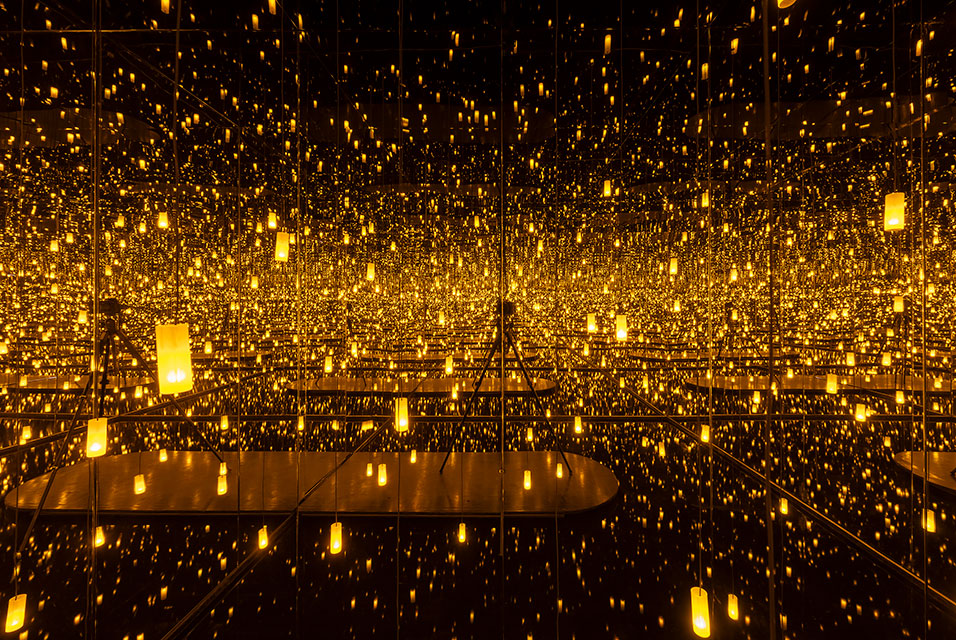Brasilian Inhotim Museum Opens Galeria Yayoi Kusama

Instituto Inhotim inaugurated its twentieth permanent gallery, dedicated to Yayoi Kusama (Matsumoto, Japan, 1929), one of the most renowned and emblematic artists working today. Galeria Yayoi Kusama features two of her works: I’m Here, But Nothing (2000) and Aftermath of Obliteration of Eternity (2009). They belong to the Instituto Inhotim Collection; the former was acquired in 2008 and the latter in 2009.
“The opening of Galeria Yayoi Kusama fulfills a central artistic ambition at Inhotim for the work of one of the most visionary artists of our time”, says Inhotim Co-Founder Allan Schwartzman. “This occasion enables us to provide a permanent presence for 3 of the artist’s most emblematic works, with Narcissus Garden (1966/2009), again drawn form Inhotim Collection, completing the artist’s presentation. Each work embodies a distinctly different environmental expression of the artist’s creative universe: the optical transformation of a darkened room into a psychological place of sensory overload; a contemplative infinity room; and a garden of suspended flotation composed of countless metallic spheres hovering above the natural landscape of Inhotim. Galeria Yayoi Kusama embodies the highest goals of Inhotim to provide unique environments for the experience of exceptional large-scale artworks for a wide-ranging and diverse audience”.
Yayoi Kusama is recognized worldwide. Her work is characterized by a creative and captivating imagination, with a diversity of mediums and languages, especially in immersive installations that invite the spectator to enter her universe, sharpening their perception. Happenings, performances, paintings, sculptures, installations, literary works and film are part of the artist’s creative world. The collective participation in her immersive installations gives meaning to her pieces, realizing an experience without limits, without boundaries, with colors, contrasts, lights and shadows.

Aftermath of Obliteration of Eternity (2009). Photo credit: Daniel Mansur.
The architectural project of Galeria Yayoi Kusama was developed by architects Fernando Maculan (MACh) and Maria Paz (Rizoma). It encompasses an area of 1,436.97 m2 located on the Orange Path, near Galeria Cosmococa and the Trails Garden. The gallery’s architectural proposal takes into consideration the protected space to house the installations and also the public, playing with the idea of waiting and lingering in a convivial space. “Given the importance of Yayoi Kusama’s work and its well known appeal to large audiences, the gallery’s project calls for a spacious waiting and preparation space,” explain the architects.
The landscaping of Galeria Yayoi Kusama features a winding path made of stones that unveils the gallery to the public, the curves of the path preceding it, arousing the curiosity of those who arrive. The landscaping project was carried out by Juliano Borin, Inhotim’s Botanical Curator, Geraldo Farias, from Inhotim’s Botanical Garden team, with contributions by Bernardo Paz. A multicolored tropical garden, with a touch of psychedelia, serves as inspiration for the planned garden where more than 4,000 bromeliads have been planted.
Repetitive patterns mark the trajectory of Yayoi Kusama’s artwork since her childhood drawings, the same time when, due to her mental health condition, she started to experience hallucinations involving recurring polka dots. Her desire to become an artist, along with family conflicts and lack of support for this endeavor, made Kusama move to the United States in the late 1950s. It was at one of her first exhibitions in New York that the artist became known for her large-scale Infinity Net Painting. As she experimented with a number of mediums and languages, Yayoi Kusama conceived increasingly audacious artistic projects for the conservative context of the time, expressing herself politically and proposing the liberation of the body through happenings and performances.
In Kusama’s work there is a overall idea that connects her works as a whole and accompanies her throughout her career - the concept of self-obliteration, which consists in the abolition of individuality in order to become one with the universe. This is expressed in the title of one of the works that are in the new gallery at Inhotim. It is in this way that Kusama reminds us that we are connected by something greater and that we are part of a whole. This sense of self-obliteration dissolves and accumulates; it proliferates and separates, at the same time it integrates us into the environment, in the quest to reach infinity through the repetition of forms.
In a 1967 performance during the screening of her film Kusama’s Self-Obliteration, Yayoi Kusama used fluorescentpaint and light to make visible her perception of the world which involves the repetition of elements such as dots and body parts. After using people as canvases for her paintings, the artist turns to transforming perception through immersive environments, as in I’m Here, But Nothing.
Image on top : I’m Here, But Nothing (2000). Photo credit: Daniel Mansur.
